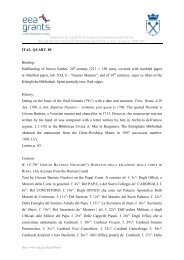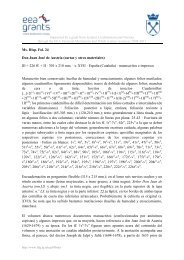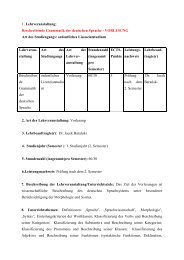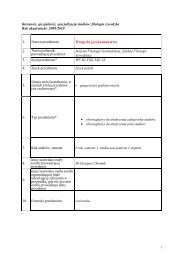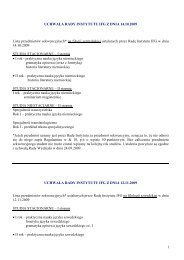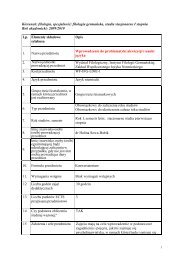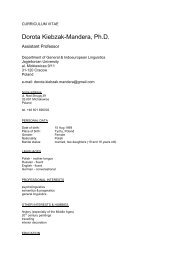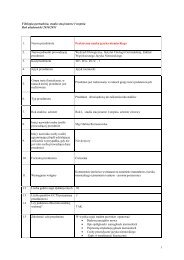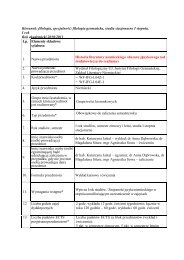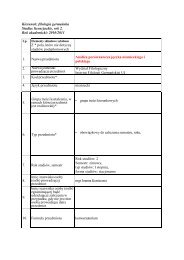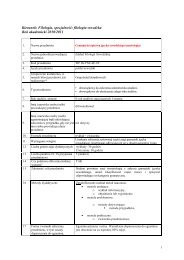MS. ITAL. FOL. 52 Libro di marmi antichi II + 52 ff. + II · 316 × 221 mm
MS. ITAL. FOL. 52 Libro di marmi antichi II + 52 ff. + II · 316 × 221 mm
MS. ITAL. FOL. 52 Libro di marmi antichi II + 52 ff. + II · 316 × 221 mm
Create successful ePaper yourself
Turn your PDF publications into a flip-book with our unique Google optimized e-Paper software.
<strong>MS</strong>. <strong>ITAL</strong>. <strong>FOL</strong>. <strong>52</strong><br />
Supported by a grant from Iceland, Liechtenstein and Norway<br />
through the EEA Financial Mechanism and Polish science resources 2008-2011<br />
<strong>Libro</strong> <strong>di</strong> <strong>marmi</strong> <strong>antichi</strong><br />
<strong>II</strong> + <strong>52</strong> <strong>ff</strong>. + <strong>II</strong> <strong>·</strong> <strong>316</strong> <strong>×</strong> <strong>221</strong> <strong>mm</strong> <strong>·</strong> 1720 <strong>·</strong> Italia (Roma)<br />
Manoscritto in buono stato <strong>·</strong> Fascicoli: 1(I+1-1) 2 + 21I 44 + 1<strong>II</strong> 48 + 2I <strong>52</strong> <strong>·</strong> Foliazione moderna a matita <strong>·</strong> Testo<br />
a piena pagina, tavole <strong>di</strong>pinte: <strong>di</strong>mensioni: (285-287) <strong>×</strong> (183-190) <strong>mm</strong> <strong>·</strong> Nomi <strong>di</strong> <strong>marmi</strong> sopra le tavole <strong>di</strong> una<br />
sola mano <strong>·</strong> (20v o ) annotazione con inchiostro: Marmj <strong>di</strong> Roma, de Varie Sorti <strong>·</strong> Fogli bianchi: tutti i verso dei<br />
fogli.<br />
Legatura rigida in pelle marmorizzata in cattivo stato, seconda metà del XV<strong>II</strong>I sec. (323 <strong>×</strong> 222 <strong>mm</strong>).<br />
Piatti in cartone. Sei nervi semplici. Sul dorso sette scomparti decorati con motivi fitomorfi impressi in oro. In<br />
alto l’etichetta in pelle marrone con il titolo impresso in oro: MARMI ANTICHI ROMAN; in basso l’etichetta<br />
rossa con la segnatura attuale. Contropiatti e carte I, IV in carta marmorizzata tipo “past, paper, combed” (cfr.<br />
Digital Collection, University of Washington, http://content.lib.washington.edu/dpweb/patterns.html). Le carte <strong>II</strong><br />
e <strong>II</strong>I con filigrana contenente lettere GR e D&C Blauw (~Heawood, I, 3267, 3267a, 3268: Haga 1747,<br />
Amsterdam c. 1769, Inghilterra 1769). Taglio rosso.<br />
Manoscritto eseguito a Roma nel 1720 a giu<strong>di</strong>care dall’annotazione a f. 1r o / in Roma del’Anno 1720 li 20/<br />
Settembre. Sotto, l’aggiunta <strong>di</strong> un’altra mano: Da Giuseppe Galli Bibiena/ Primo Ingegnere ed Architetto<br />
Teatrale <strong>di</strong> Sua/ Maesta Cesarea Carlo Sesto Imperadore, eseguita dopo il 1729, l’anno in cui all’artista venne<br />
conferito il titolo <strong>di</strong> ingegnere e architetto della corte asburgica. Quin<strong>di</strong> l’autore del co<strong>di</strong>ce può essere stato lo<br />
stesso Galli Bibiena o comunque esso fu eseguito nella sua bottega. Nel processo <strong>di</strong> rilegatura del volume,<br />
avvenuto più tar<strong>di</strong>, il lembo superiore dei fogli venne leggermente tagliato. La legatura fu e<strong>ff</strong>ettuata prob. nella<br />
seconda metà del XV<strong>II</strong>I sec. a giu<strong>di</strong>care dalla carta marmorizzata usata per i contropiatti (cfr. sopra) e le<br />
filigrane delle carte <strong>di</strong> guar<strong>di</strong>e. Le filigrane <strong>di</strong> questo tipo apparivano in <strong>di</strong>verse varianti in Olanda nel sec.<br />
XV<strong>II</strong>I. Nel 1772 il produttore <strong>di</strong> carta italiano Valentino Galvani ebbe la licenza <strong>di</strong> usare il marchio D&C Blauw<br />
per la carta <strong>di</strong> alta qualità che produceva nelle cartiere <strong>di</strong> Cordenons sul Viazzol (Friuli). Comunque le iniziali<br />
GR e non VG presenti nella carta usata nel ms. permettono <strong>di</strong> ipotizzare anche la sua provenienza olandese.<br />
Inizialmente il co<strong>di</strong>ce apparteneva al suo autore in seguito passò ad altri proprierari. A f. 1 r o vi è una traccia <strong>di</strong><br />
annotazione cancellata, il che potrebbe suggerire qualche tra<strong>ff</strong>ico poco lecito. In basso ad inchiostro la firma:<br />
Moehsen. Infatti uno dei proprietari del co<strong>di</strong>ce fu il noto me<strong>di</strong>co, bibliofilo e numismatico Johann Karl Wilhelm<br />
Moehsen (1722-1795), della cui raccolta la Königliche Bibliothek si arricchì nel 1796. Il co<strong>di</strong>ce è notato appunto<br />
nell’antico catalogo della biblioteca, Cat A 356, c. 134, n. 77 in reparto Antiquaria in Folio, come parte<br />
dell’acquisto del 1796. La segnatura attuale Ms.ital.Fol.<strong>52</strong> sull’etichetta rossa sul dorso e a f. 1r o ; timbro della<br />
Königliche Bibliothek a <strong>ff</strong>. 1v o e <strong>52</strong>v o .<br />
Le<strong>mm</strong>, p. 71.<br />
http://www.filg.uj.edu.pl/fibula/
Supported by a grant from Iceland, Liechtenstein and Norway<br />
through the EEA Financial Mechanism and Polish science resources 2008-2011<br />
<strong>ff</strong>. 1r o -<strong>52</strong>v o . LIBRO DI MARMI ANTICHI (1r o ) Titolo. ><strong>Libro</strong> de Marmi Antichi/ Cavati dalle<br />
Fabriche/ Antiche Romane/ in Roma del’Anno 1720 li 20/ Settembre. Da Giuseppe Galli<br />
Bibiena/ Primo Ingegnere ed Architetto Teatrale <strong>di</strong> Sua/ Maesta Cesarea Carlo Sesto<br />
Imperadore< (2r o -<strong>52</strong>r o ) Campioni <strong>di</strong> <strong>marmi</strong>. (2r o ) – Marmo Bianco; (3r o ) – Giallo Antico<br />
Breciato; (4r o ) – Corallino Antico; (5r o ) – Bianco e Nero moderno; (6r o ) – Brecia <strong>di</strong> Francia;<br />
(7r o ) – Pietra Cotanella; (8r o ) – Alabastro Montanaro; (9r o ) – Sasso Breciato Antico; (10r o ) –<br />
Pidochioso Antico; (11r o ) – Diaspro <strong>di</strong> Sicilia; (12r o ) – Lumachella Antica; (13r o ) – Bianco e<br />
Nero Antico; (14r o ) – Pietra Ardese; (15r o ) – Granito Orientale; (16r o ) – Verde <strong>di</strong> Porto<br />
Venere; (17r o ) – Porfido Orientale Rosso; (18r o ) – Brecia Orata Antica; (19r o ) – Verde<br />
Antico; (20r o ) – Broccatello Antico; (21r o ) – Diaspro Duro Orientale; (22r o ) – Agata<br />
Sardonica Orientale; (23r o ) – Alabastro Antico Diverso; (24r o ) – Bar<strong>di</strong>glo Venato a Ochy;<br />
(25r o ) – Brecia <strong>di</strong> Verona; (26r o ) – Africano; (27r o ) – Alabastro Fiorito a Vena Antico; (28r o )<br />
– Negro <strong>di</strong> Paragone; (29r o ) – Diaspro Verde a Vena; (30r o ) – Alabastro Antico Agatato;<br />
(31r o ) – Brecia Antica Diversa; (32r o ) – Alabastro Agato; Diverso (33r o ) – Marmo Cipollino;<br />
(34r o ) – Brecia Castracanara; (35r o ) – Rosso Antico; (36r o ) – Serpentino Antico; (37r o ) –<br />
Alabastro <strong>di</strong> Ponte mollo; (38r o ) – Fior <strong>di</strong> Perzico Antico; (39r o ) – Giallo <strong>di</strong> Verona; (40r o ) –<br />
Verde <strong>di</strong> Piombino; (41r o ) – Pietra Ametista; (42r o ) – Agata Lattuaria Orientale; (43r o ) –<br />
Porta Santa; (44r o ) – Apis Lazzaro a Nuvola; (45r o ) – Brecia <strong>di</strong> sete Base Antica Diversa;<br />
(46r o ) – Diaspro Orientale; (47r o ) – Alabastro Antico Diverso; (48r o ) – Alabastro Fiorito;<br />
(49r o ) – Brecia Pavonaza Antica; (50r o ) – Castracano Antico; (51r o ) – Diaspro Fiorito; (<strong>52</strong>r o )<br />
– Alabastro Orientale. Il ms. costituisce una specie <strong>di</strong> campionario contenente illustrazioni<br />
con 51 <strong>di</strong>versi tipi <strong>di</strong> marmo. Dal frontespizio risulta che l’autore era Giuseppe Galli Bibiena<br />
(c. 1695-1757), membro della famiglia dei famosi architetti, pittori e scenografi. Giuseppe,<br />
figlio <strong>di</strong> Fer<strong>di</strong>nando acquistò la fama per scenografie teatrali allestite in tutta l’Europa (Italia,<br />
Vienna, Stoccolma, Bayreuth, Dresda e altri). Nel 1727 <strong>di</strong>venne architetto <strong>di</strong> corte degli<br />
Asburgo. È autore dell’opera “Architetture e prospettive”, (1740-1744) de<strong>di</strong>cata<br />
all’imperatore Carlo VI. (cfr. DBI Giuseppe Galli Bibiena, s.v , AA.VV., “I Galli Bibiena:<br />
una <strong>di</strong>nastia <strong>di</strong> architetti e scenografi”, (a c. <strong>di</strong>) D. Lenzi, Bibbiena 1997). Testo ine<strong>di</strong>to.<br />
http://www.filg.uj.edu.pl/fibula/



